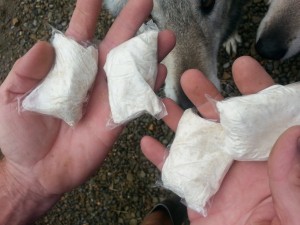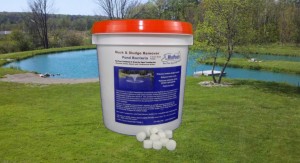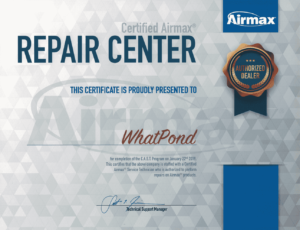There are bacteria all around us, some good, and some bad even some that can be deadly. Our focus is the good guys we use for healthy, clean water and eliminating muck.
The good pond bacteria already exist in and around our ponds, but they’re not overly abundant to do the job, or to keep up with the job of eliminating muck and reducing nutrients.
Let’s take a quick look at the two types of pond bacteria in our ponds now. The first one thrives in oxygen, needs oxygen to live and grow and is called aerobic bacteria. These guys are very active in their job of reducing the dead decaying plants and nutrients from fish waste suspended organics and what the rain brings in to the pond. This in turn reduces our mucky bottom of the pond, where oxygen is present.
The second type of pond bacteria lives in low or no oxygen atmosphere generally towards the bottom of the pond. They really don’t thrive and are very slow in reducing muck. This is actually why ponds fill in over the years. These anaerobic bacteria cannot keep up with the nutrient load coming into the pond and from what is in the pond, fish waste, dying plants and whatever washes into the pond like geese waste. As these anaerobic bacteria do their job they release, or their waste is hydrogen sulfide and carbon dioxide which usually stays at the bottom of the pond and accumulate year after year eventually posing and fish kill.
Now we see the good and bad pond bacteria and what they do in the pond but we need to help the good guys do more work and remove the bad guys waste since they are not keeping up with the job and so slow they are hurting the ponds health. These bad guys (anaerobic bacteria) waste is hydrogen sulfide and carbon dioxide that leaves that bad smell when the pond turns over or when you step into the pond.
We have two options in eliminating muck, nutrients, odors and murky water. The first option is too simple add a beneficial pond bacteria every other week around the edges of the pond with our easy to apply water soluble packets or pellets and let them get to work. The beneficial pond bacteria will multiply and get to work on the muck and decaying debris up to a point where there is little oxygen for them to live.
The second part is proper aeration for the pond, where we design the aeration system to be sure we can turn over the entire volume of water at least once a day which will be sufficient to supply the oxygen demands the pond needs. With the added aeration system in the depths of the pond we are creating an oxygen rich atmosphere in the depths of the pond for the beneficial pond bacteria’s to thrive and are now able to consume muck and suspended solids at the bottom of the pond, where they couldn’t before.
The easiest plan for a healthy pond is to apply our beneficial pond bacteria around the edge of the pond, the aeration system running, moving water and supplying oxygen out in the depths of the pond our additional beneficial pond bacteria around the edge can multiply and move into the depths of the pond.
The recommended treatment is every other week or once a month. This depends on the pond and your aggressiveness at eliminating muck or the pond’s needs to keep it clean and clear.
We’ve experimented a couple years on the every other week then we would try once a month. If the pond started showing algae then we would go back to every other week, but for the most part with aeration and adding beneficial pond bacteria we can manage and keep control of the situation and adjust dosage or when we add the beneficial pond bacteria.
Beneficial pond bacteria application:
The recommended dosage or application for our bacteria is 4 pounds per acre as a maintenance dose. This means a ½ acre pond would use 2 pounds and a ¼ acre pond only one pound per acre. Smaller ponds we use an ounce per 1,000 gallons every week or as needed.
Using pond bacteria is a science but not an exact science, not two ponds are alike and different ponds react differently to the beneficial pond bacteria’s meaning ponds that are spring fed are cooler and the beneficial pond bacteria performance will be slower than a pond that is stagnant which would be much warmer. The beneficial pond bacteria are active from 35-90 degrees but most active 60 degrees and above.
Another difference is the pond water quality or nutrient loading in the pond from incoming nutrients to fish loads and amount of muck in the pond. If it is a dirty pond or old pond we may want to do applications on a weekly basis instead of bi-weekly. Another option is to double the dose or add half an extra dose per application.
So far we have been talking about our powered beneficial pond bacteria in the water soluble packets but we also have the pellets in 3 gram or one ounce blocks. They are a little different in makeup to tackle the muck in the pond, sink to the bottom quicker and sink into the muck a little bit. Now I’m sure you’ve seen the statement of “blank” inches of muck recovered per year but remember each pond is different. There was a pond that had 30” of muck remover in a year but in this case, money was no object and the doses were very heavy.
Beneficial pond bacteria works, but a onetime application is not the way it work, it needs to be kept going when the water is above 55 degrees. Picture a sparkler like on the 4th of July. It takes a little time to get it lit but once it is going it sparkles like crazy for a duration of time. Once it reaches the end it dies out. Similar to the beneficial pond bacteria, they are in a spore for in the powder or pellets; once they come to life they do multiply and spread through the pond but eventually die off and slow down their effectiveness. This is the reason for the bi-weekly treatment, keeping these Beneficial Pond Bacteria thriving all season long.
The ongoing process of adding beneficial pond bacteria would be needed to keep the pond clean, clear and healthy and or to continue removing muck. This is a year after year process when the pond is above 55 -60 degrees. Again it depends on the pond and the nutrients that are coming into the pond and what is in the pond from fish and dyeing plants. Once the pond clears or enough muck is removed you can experiment with the application by skipping a week or go on a monthly treatment to see how the pond reacts. But remember if the pond does get out of whack it will take time for the beneficial pond bacteria to catch up again.
The difference in the pellets or packets can be looked at in two ways. They both are Beneficial Pond Bacteria’s, while the packets work more for water clarity the pellets work more for the bottom muck. But they both can be used at the same to to keep the pond looking great.
One more thing, seasonal treatments like spring and fall pond bacteria are really not needed since our beneficial pond bacteria works from 35-90 degrees. We could make up a new label for cool water bacteria but why? We like to stick with the 55-60 water temp when the bacteria is most active to do the most amount of work they can.
Related article Heavy Rains and runoffs.
See all of our Beneficial Pond Bacteria products on our private pond supply page.




Comments on this entry are closed.